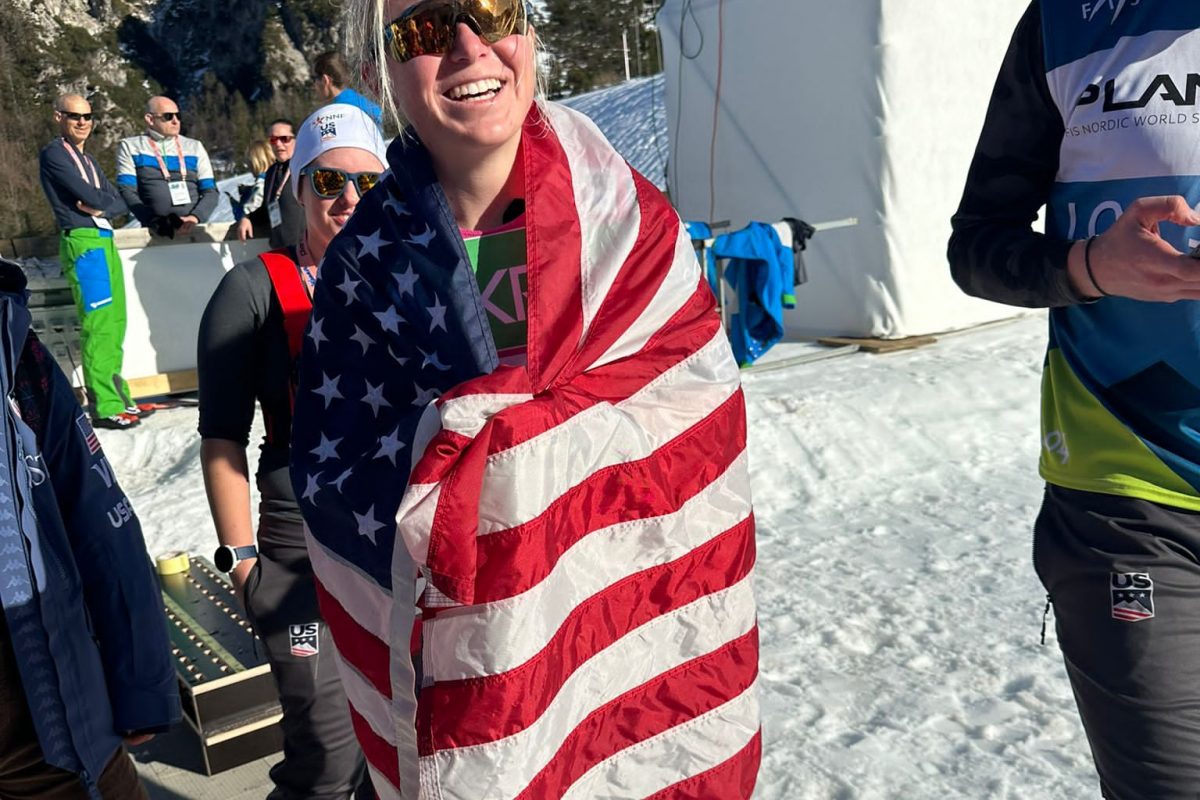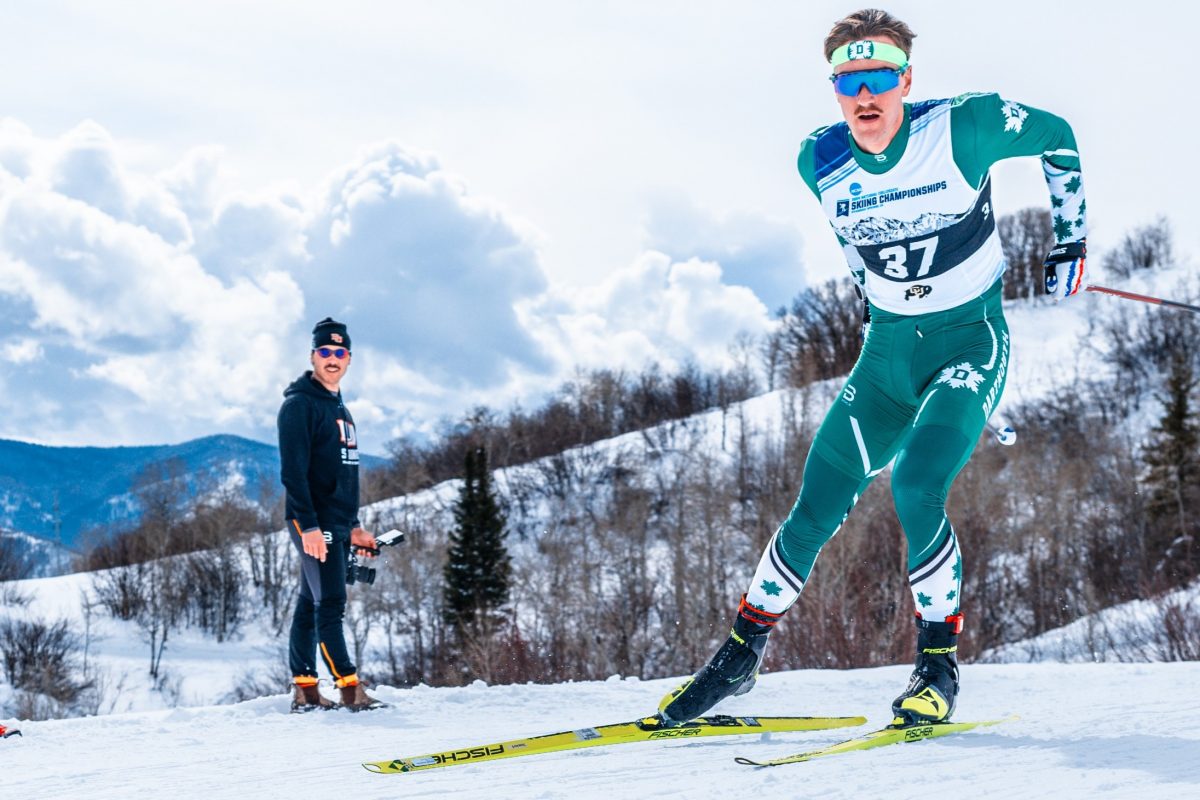
CRAFTSBURY, Vermont — If anyone can attest to the fact that feeling off during a qualifier is no reason to count oneself out for the heats, it’s Dartmouth senior Eric Packer. Despite having “blown up a bit” in the classic sprint prelim at SuperTour Finals on Tuesday, qualifying in 16th, he didn’t throw up his hands in defeat. Instead, he went on to win the thing outright, beating SuperTour regulars and US Ski Team members in the process.

After his rocky start, Packer focused on conserving energy as he made his way through the heats, skiing just as fast as necessary in order to advance automatically to each subsequent round. He was second in his quarterfinal and third in his semi, and let off the gas as soon as he knew he was safe.
The same strategy applied to Packer’s progress through the A-final.
“In the final I tried to wait as long as possible,” he said.
The course featured a fairly quick descent right out of the start. The six tracks off the line disappeared within a few seconds and almost immediately skiers dropped into tucks around a sweeping right-hand downhill corner. From there, the course was mostly downhill until the low point, where it was steady climbing back to the stadium.
Packer was positioned on the far left at the gun, but managed to cruise out of sight of the stadium in a decent position near the front.
In the woods, Packer sat in the middle of the pack as the field began to climb back up to the finish. That was where eventual runner-up Reese Hanneman (APU) made his move.

“The second half of the course was where it was all made; it’s basically all uphill,” said Hanneman. “I focused on trying to throw it down right on the top of that big climb.”
As Hanneman pushed the pace, Packer knew he had to go with him.
“The key was to have something left in your legs for that last bit,” said Packer. “A lot of people were doing great at the top of the big hill and then started fading coming into the finish, so I just knew I had to go hard there to have a good shot.”
Packer is no stranger to the top of the podium — he notched three individual collegiate carnival wins this season alone — but to do the same against the professionals at the end of a winter that included carnivals, World U23 Championships, NCAAs and Canadian Nationals?

“I was really happy; this is a good day for me,” said a smiling Packer.
The sprint wasn’t just a good day for the winner. For Hanneman in second and Karl Nygren (CXC) in third, Tuesday’s results were some of their best all season, and came despite the return of the big guns from the World Cup.
“I knew I could be [up there]; I’ve had some really good classic qualifiers and heats this year. It was just about putting four of them in a row,” said Hanneman. “It’s probably one of my better days so far this year. It’s nice to get that feeling, that positive reinforcement.”
Nygren, like Packer, came on strong later in the day despite qualifying in a lukewarm position.
“I felt pretty good,” said Nygren.
Fast skis enabled him to maneuver around people on the down hills, which gave him extra speed as the course started to go back up.
“I was able to…take it easy on the big hill and try to close at the end,” he said. “It worked out all right.”

He qualified in 13th, but went on to win his quarterfinal and semifinal. Nygren’s semifinal included the likes of Simi Hamilton (SVSEF/USST) and Erik Bjornsen (APU/USST), who were part of the closest finish of the entire day.
When the field came into view of the finish, there were four men vying for three spots: Nygren, Bjornsen, Kris Freeman (SSCV/USST) and Hamilton.
Nygren won the photo finish and Bjorsen taking the second spot. Freeman, who is more of a distance specialist, managed to get his toe in front of Hamilton’s and advance to the A-final, leaving Hamilton out.
“I put everything I had into the semi, and getting a foot in front of Simi Hamilton is no easy feat,” said Freeman.
If one key to the course was saving enough for the final climb, another was simply staying upright. Several big names were taken out by crashes throughout the day. Hamilton fell and broke a ski during the B-final, taking Tyler Kornfield (UAF) down with him, and crossed the line well after his competitors.
“I was right behind Sim and it looked like his klister stuck — I don’t know, he basically went head over heals,” said Tim Reynolds (CGRP), who stayed upright but broke a pole in the tangle and also finished way off the heat leaders.

Erik Bjornsen (APU/USST) fell twice during the A-final: once in a tangle with Kris Freeman (SSCV/USST) and then immediately again due to resulting iced skis.
“I got up pretty slowly, shaking my head, and then I realized out of the corner of my eye that there was still someone behind me,” said Bjornsen.
That someone was Sylvan Ellefson (SSCV), who had run out of gas after posting the fastest qualifying time and blazing through the heats.
“I lost energy today,” said Ellefson, who is still nursing a swollen ankle. “I felt good coming into the low part of he course and as soon as we started climbing, nothing was really moving as fast as it had been earlier this morning.”
From the time the qualifiers began at 9:00 am to the end of the heats after noon, the once rock-hard snow had softened. The sun baked the final ascent that directly faced it, making the climb all the more challenging.
Most notably absent from the results on Tuesday was USST sprinter Andy Newell, who arrived in Vermont on Monday after finishing off his European season at the Red Bull NordiX sprint in Oslo, Norway on Saturday. To recover from a sore throat contracted somewhere in between, Newell decided to sit out the races and cheer on his teammates.
Also of note was Noah Hoffman’s (SSCV/USST) quarterfinal crash. After a promising eighth-place qualifier, Hoffman fell and dislocated the same shoulder that gave him repeated dislocation problems before his surgery last spring. He planned to have the shoulder x-rayed Tuesday afternoon to determine whether he should race on Wednesday.
“The surgery was supposed to make sure this didn’t happen again, so I don’t know what this means,” said Hoffman.
After a grueling day of sprinting, athletes have to rest up and recover in time for a 10:00 am start on Wednesday morning at the base of nearby Jay Peak for the 1.8 k, 1,079-foot hill climb up a blue square trail.
Alex Matthews contributed reporting.
Audrey Mangan
Audrey Mangan (@audreymangan) is an Associate Editor at FasterSkier and lives in Colorado. She learned to love skiing at home in Western New York.



